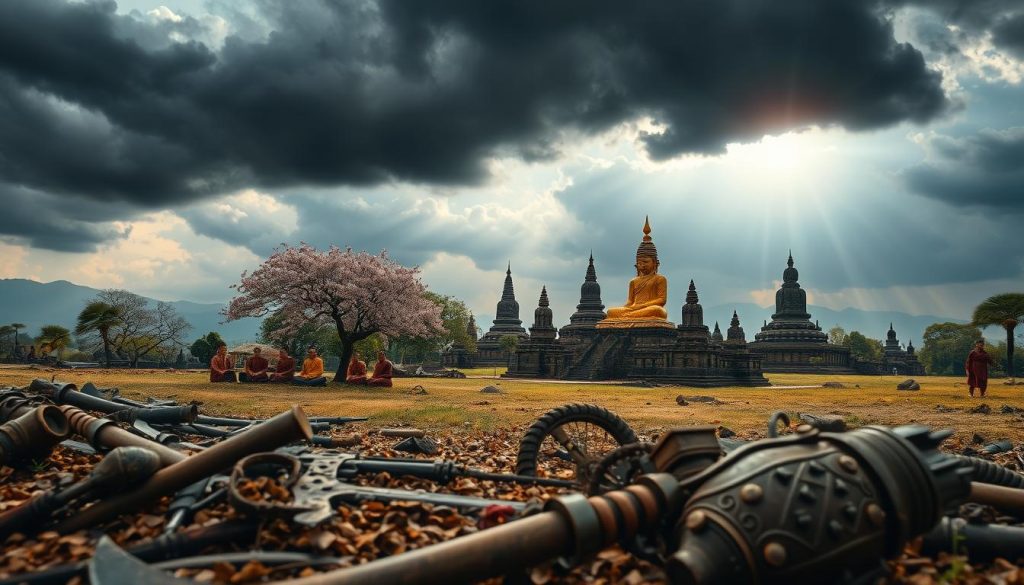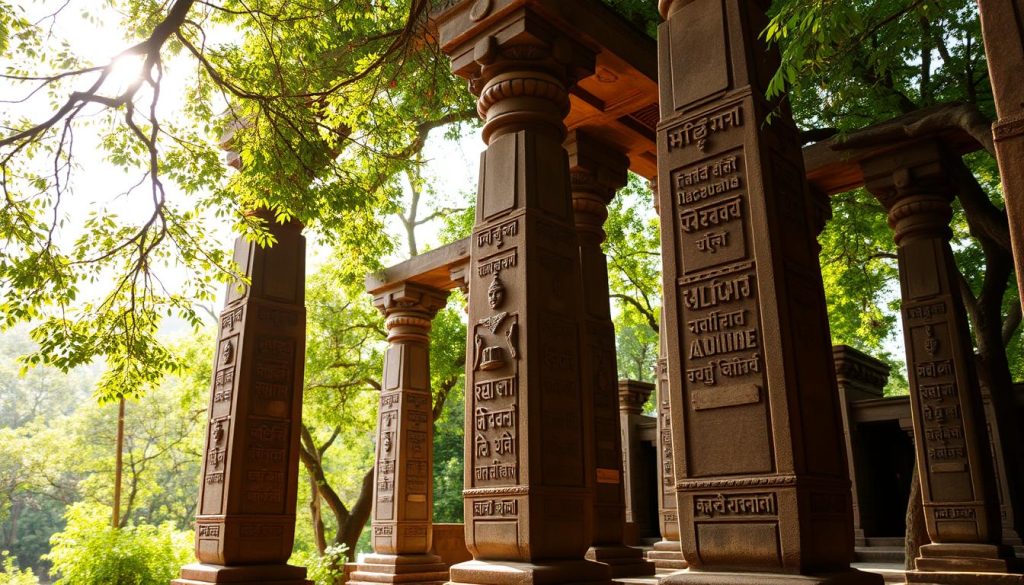Kalinga Empire: Ancient Kingdom of Eastern India
Imagine a time when the vast Indian subcontinent was ruled by the mighty Kalinga Empire. This ancient kingdom left a lasting impact on the region’s culture and politics. Located in today’s Odisha, it was a major force in ancient Indian history, with its legacy still felt today.
The Kalinga Empire’s story is one of greatness and strength. It shows the lasting spirit of its people. With its deep traditions, strong military, and big influence on Buddhism, Kalinga’s role in India’s history is huge. As we explore this ancient kingdom’s history, we find stories that amaze and motivate us today.

Key Takeaways
- The Kalinga Empire was a powerful ancient kingdom located in present-day Odisha, India.
- It played a significant role in the cultural and political landscape of the Indian subcontinent.
- The empire’s military might, rich traditions, and influence on the spread of Buddhism are key aspects of its legacy.
- Exploring the history of the Kalinga Empire provides valuable insights into ancient Indian history.
- The region’s cultural heritage and archaeological treasures continue to fascinate scholars and the public alike.
Origins and Early History of the Kalinga Empire
The Kalinga kingdom in eastern India has a rich history. It dates back thousands of years. Located in what is now Odisha, it was key in shaping ancient Indian history.
Geographic Boundaries of Ancient Kalinga
The Kalinga kingdom was huge, from the Mahanadi River to the Godavari River. Its spot by the Bay of Bengal helped it grow through trade. This made it strong economically and culturally.
Early Rulers and Dynasty Formation
The Kalinga kingdom started in the 6th century BCE. The Mahameghavahana dynasty ruled then. Kharvela and others expanded Kalinga’s power and influence.
Political Structure in Early Kalinga
- The Kalinga kingdom had a strong central government, with the king in charge.
- It was split into smaller areas, each run by local leaders who followed the king.
- A detailed bureaucracy handled records, taxes, and policies.
| Characteristic | Description |
|---|---|
| Centralized Governance | The Kalinga kingdom had a strong central authority, with the monarch as the supreme ruler. |
| Administrative Divisions | The kingdom was divided into smaller administrative units, each governed by local chieftains or feudal lords. |
| Bureaucratic System | Kalinga had a well-developed bureaucracy responsible for maintaining records, collecting taxes, and implementing policies. |

The early days of the Kalinga kingdom show a complex system. It was strategic, strong, and well-governed. This made Kalinga a major player in ancient Indian history.
What is the historical significance of the Kalinga Empire in Odisha?
The Kalinga Empire is very important in Odisha’s history. It was a powerful kingdom that ruled the eastern coast of India. Its influence went beyond its borders, shaping politics, society, and art in the region.
Kalinga played a big role in spreading Buddhism in India. After the Kalinga War, Emperor Ashoka became a Buddhist. This change had a big impact on Odisha’s culture and religion. Today, you can see this in many ancient Buddhist sites and artifacts.
| Significance of the Kalinga Empire | Impact on Odisha |
|---|---|
| Spread of Buddhism | Numerous ancient Buddhist monasteries and relics |
| Architectural and Artistic Achievements | Lasting influence on regional art, architecture, and craftsmanship |
| Maritime Trade and Exploration | Established Odisha as a hub of international commerce and cultural exchange |
The Kalinga Empire also left a mark on Odisha’s art and architecture. The temple carvings and sculptures found at excavation sites show the region’s rich heritage. They still inspire artists today.
The empire’s maritime trade and exploration helped make Odisha a center of international commerce. Its seafaring skills and trade networks connected it to other lands. This exchange of ideas, goods, and art has shaped Odisha’s unique identity.
In summary, the Kalinga Empire’s impact on Odisha is vast. It spread Buddhism, developed art and architecture, and expanded trade and exploration. These legacies continue to influence Odisha’s culture, making the Kalinga Empire a key part of its history.

The Great Kalinga War: Turning Point in Indian History
The Mauryan Empire, under Emperor Ashoka, was at its peak when it faced the Kalinga kingdom. This battle, known as the Kalinga War, was a turning point. It showed the Mauryan army’s strength and changed Ashoka’s beliefs and policies.
Causes of the Kalinga War
The Kalinga War started because the Mauryan Empire wanted to grow. Kalinga, a rich kingdom on India’s east coast, was a key target. The rivalry between the two powers made the conflict worse.
Battle Strategies and Military Might
The Kalinga War was intense and bloody. Both sides used advanced tactics and showed their military strength. The Mauryan army, led by Ashoka, was known for its discipline and powerful forces. Kalinga had skilled archers and strong defenses. In the end, the Mauryans won.
Aftermath and Transformation of Ashoka
The Kalinga War was a turning point for Ashoka and the region. The heavy loss of life deeply affected Ashoka. He then turned to Buddhism, renouncing violence. This change had a lasting impact on the Mauryan Empire and Indian history.
Buddhist Influence and Religious Transformation
The ancient kingdom of Kalinga saw a big change in religion after the Kalinga War. Emperor Ashoka then turned to Buddhism. This change deeply affected the culture, society, and buildings of the area.
Ashoka became a big supporter of Buddhism after his conversion. He built many Buddhist sites, including the famous Dhauli rock edicts. These inscriptions show his commitment to peace and spreading Buddhist teachings.
- The Dhauli rock edicts show how Buddhist influence changed Kalinga. They record Ashoka’s shift from war to peace and good governance.
- Buddhist monasteries and temples were built across Kalinga. Monks and scholars helped spread Buddhist teachings and art.
The lasting effect of this change is seen in Odisha’s culture today. Kalinga’s art and buildings show Buddhist styles and symbols.
“The spread of Buddhism in Kalinga marked a significant turning point in the region’s history, shaping its spiritual and cultural identity for centuries to come.”
The Dhauli rock edicts and Buddhist influence in Kalinga still fascinate people. They show the deep changes in this ancient kingdom.
Archaeological Treasures of the Kalinga Empire
The Kalinga Empire was an ancient kingdom in eastern India. It left behind many archaeological wonders. These include the famous Dhauli rock edicts, ancient temples, and monasteries. They show the rich cultural heritage of the region.
Dhauli Rock Edicts
The Dhauli rock edicts are a key find from the Kalinga Empire. They were carved into the Dhauli hills by Emperor Ashoka. These edicts give us a peek into the political and social changes after the Kalinga War.
Ancient Temples and Monasteries
The Kalinga Empire was known for its impressive buildings. It built many temples and monasteries. These, like the Lingaraj Temple and Ratnagiri Monasteries, show the skill of the Kalingan builders.
Excavated Artifacts and Their Significance
Archaeologists have found many artifacts from the Kalinga Empire. These include sculptures, pottery, and metalwork. They help us understand the art, culture, and daily life of the Kalingans.
| Archaeological Treasure | Significance |
|---|---|
| Dhauli Rock Edicts | Provide historic insights into Ashoka’s reforms and the transformation of the region after the Kalinga War |
| Lingaraj Temple | Exemplifies the architectural marvels and religious devotion of the Kalinga Empire |
| Ratnagiri Monasteries | Showcase the region’s thriving Buddhist culture and intellectual pursuits |
| Intricate Sculptures | Reflect the artistic sophistication and craftsmanship of the Kalingan people |
The archaeological treasures of the Kalinga Empire still fascinate scholars and visitors. They give us a glimpse into the rich history and cultural legacy of this ancient kingdom.
Trade and Maritime Excellence
The Kalinga Empire was known for its amazing sea skills and wide trade networks. It was a key player in the Indian Ocean trade. This coastal kingdom helped share cultures and goods between ancient India and other lands, making a lasting impact on ancient Indian history and cultural legacy.
Kalinga’s spot on the eastern coast made it a major trade center. Its sailors and traders reached out to places like Indonesia, Malaysia, and Thailand. This exchange of goods and ideas made the cultural legacy of Kalinga and the area richer.
Kalinga’s sea power went beyond just trade. It was also known for its naval battles and explorations. Its ships and sailors explored the Indian Ocean, finding new paths and making friends with far-off lands. This helped Kalinga grow and become a key player in ancient Indian history.
“Kalinga’s maritime legacy is a testament to the ingenuity and adventurous spirit of its people, who embraced the vast ocean as a gateway to prosperity and cultural exchange.”
Kalinga’s trade and sea skills still influence the area today. You can see its impact in the architecture, arts, and food of modern-day Odisha.
Cultural Heritage and Artistic Achievements
The Kalinga Empire’s cultural legacy is a testament to its rich heritage and artistic prowess. It boasts distinctive architectural marvels and impressive sculptural traditions. Odisha’s ancient kingdom has left a lasting mark on the region’s cultural landscape.
Architecture and Sculpture
The Kalinga Empire’s architectural achievements are truly awe-inspiring. The region is home to ancient temples and monasteries that showcase the empire’s mastery of stone carving and construction. The iconic Konark Sun Temple, with its intricate carvings and astronomical precision, stands as a testament to the Kalingas’ architectural brilliance.
In addition to their architectural marvels, the Kalingas were renowned for their exceptional sculptural traditions. The region’s ancient temples and monasteries are adorned with exquisite stone carvings. These sculptures depict gods, goddesses, and scenes from Hindu epics. They showcase the Kalingas’ artistic talent and provide a window into the empire’s rich cultural and religious beliefs.
Literature and Language Development
The Kalinga Empire’s cultural legacy extends beyond its architectural and sculptural achievements. The region made significant contributions to literature and language. The Kalingas were known for their sophisticated literary traditions, producing a wealth of poetry, drama, and scholarly works.
- The Kalingas developed a unique regional language, Odia, which has become an integral part of Odisha’s cultural identity.
- The empire’s literary works, such as the epic Kalinga-Vijaya, offer insight into the Kalingas’ historical narratives and cultural values.
- The Kalingas’ linguistic achievements have had a lasting impact on Odisha’s cultural legacy, shaping the region’s literary and linguistic landscape for centuries.
The Kalinga Empire’s cultural heritage and artistic achievements continue to captivate and inspire people across India and beyond. From its architectural marvels to its literary contributions, the legacy of this ancient kingdom remains a source of immense pride and cultural identity for the people of Odisha.
Legacy and Modern-Day Impact on Odisha
The Kalinga Empire’s rich heritage still echoes in Odisha today. It has deeply shaped the state’s identity and traditions. The influence of Kalinga’s past is clear in its architecture and cultural practices.
Cultural Continuity in Modern Times
Odisha’s culture is still tied to the Kalinga Empire’s traditions. The state’s festivals, handicrafts, and temples show Kalinga’s artistic and spiritual legacy. The Konark Sun Temple, a UNESCO World Heritage Site, is a marvel from the Kalinga era.
Archaeological Conservation Efforts
Efforts are underway to protect Odisha’s Kalinga heritage. Authorities are restoring ancient temples and studying Kalinga artifacts. These efforts keep Odisha’s cultural legacy alive for future generations.
FAQ
What is the historical significance of the Kalinga Empire in Odisha?
The Kalinga Empire was a major power in ancient Odisha, now eastern India. It greatly influenced the area’s culture and politics. Its legacy can be seen in its architecture, the spread of Buddhism, and its role in trade and the sea.
How did the Kalinga War impact the Mauryan Empire and Emperor Ashoka?
The Kalinga War was a key event in Indian history. It was brutal and changed Emperor Ashoka’s life. He became a Buddhist after seeing the war’s horrors. This change helped the Mauryan Empire become more peaceful and open.
What are some of the notable archaeological treasures associated with the Kalinga Empire?
The Kalinga Empire left many treasures, like the Dhauli rock edicts. These edicts tell us about Emperor Ashoka. The area also has ancient temples, monasteries, and artifacts that show the empire’s culture and technology.
How did the Kalinga Empire contribute to the cultural legacy of Odisha?
The Kalinga Empire’s culture is still seen in Odisha today. Its architecture, sculptures, and literature helped shape the region. Efforts to save these treasures keep the empire’s legacy alive in Odisha.
What was the extent of the Kalinga Empire’s maritime and trade capabilities?
The Kalinga Empire was known for its sea skills and trade. It traded with Southeast Asia, sharing cultures and goods. Its coastal location and sea knowledge made it a key trading center in the ancient world.







